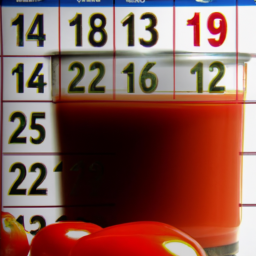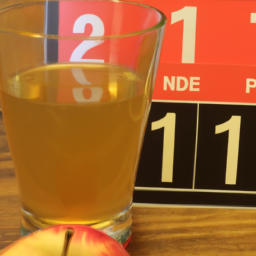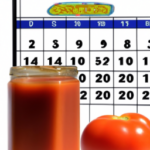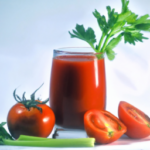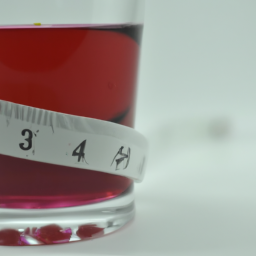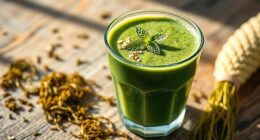Being a fan of everything tomato-related, I always ensure my pantry is well-stocked with canned tomato juice. It’s perfect for crafting a revitalizing drink in the morning or for infusing richness into a from-scratch pasta sauce—making canned tomato juice an indispensable staple in the kitchen.
But like any food item, I often wonder: how long does canned tomato juice last before it goes bad? As the saying goes, ‘knowledge is power,’and understanding the shelf life of canned tomato juice is key to avoiding food waste and potential health risks.
In this article, we’ll delve into the factors that affect the shelf life of canned tomato juice, how to properly store it, and even explore alternative uses for expired tomato juice. So, let’s get started and become tomato juice shelf life experts!
Key Takeaways
- Proper storage is crucial for maximizing the shelf life of canned tomato juice.
- Spoilage signs include mold growth, discoloration, off-putting odors or flavors, and sediment at the bottom of the can.
- Canned tomato juice can last for up to two years if stored properly.
- Freezing canned tomato juice can extend its shelf life.
Factors Affecting Shelf Life
You’ll want to take into account various factors that can impact how long your canned tomato juice will last. Factors affecting shelf life include taste quality, storage environment, canning techniques, and recipe ideas.
In order to ensure the longest possible shelf life for your canned tomato juice, it’s important to store it in a cool, dry place, away from direct sunlight or heat sources. Additionally, be sure to follow proper canning techniques when preparing your juice, such as using clean jars and lids and following recommended processing times.
When it comes to taste quality, canned tomato juice may start to lose flavor or develop a metallic taste over time. If you find that your juice no longer tastes as fresh as it once did, consider using it in recipes or for alternative uses, such as donating it to a local food bank.
Understanding expiration dates can also help you determine when it’s time to use or dispose of your canned tomato juice. Be sure to check the label for the date of canning or expiration, and use the juice within the recommended time frame for best results.
Understanding Expiration Dates
Understanding expiration dates can be like reading a language from another planet, but once decoded, they reveal the true freshness of the product. The main purpose of expiration dates is to inform consumers about the safe consumption period of a particular food item.
However, many people are confused about how to read the labels and often end up throwing perfectly good food away. To avoid this, it’s essential to understand the different types of expiration dates that are commonly found on food products.
There are two types of expiration dates: ‘best by’ and ‘use by’. ‘Best by’ dates indicate the time frame within which the product will be at its peak quality, while ‘use by’ dates indicate the time frame within which it’s safe to consume the product. It’s important to note that consuming food past its ‘use by’ date could be harmful to one’s health. To avoid confusion, it’s advisable to always check the expiration date before purchasing canned tomato juice or any other food item.
With this knowledge, one can make informed decisions about the freshness and safety of the product.
Moving on to the next section, signs of spoilage can indicate whether or not canned tomato juice has gone bad.
Signs of Spoilage
As a consumer, it’s important for me to know the signs of spoilage in canned tomato juice. The appearance of the juice can be a clear indicator of spoilage, such as mold growth or discoloration.
The smell and taste of the juice can also be telling, with off-putting odors or flavors indicating that the product has gone bad.
Appearance
If you crack open a can of tomato juice that’s been sitting in your pantry for too long, you might feel a sense of disappointment when you see the dull, lackluster appearance. This is because the preservatives and additives that are typically found in canned tomato juice will eventually break down over time, causing the juice to lose its bright red color and become murky.
The juice may also appear to have sediment at the bottom of the can, which is another sign of spoilage. When it comes to canned tomato juice, appearance is a crucial indicator of whether the juice is still safe to consume. If you notice any changes in the color or consistency of the juice, it’s best to err on the side of caution and dispose of the product.
As we move on to the next subtopic, it’s important to note that the appearance of the juice is just one of several signs to look out for when determining whether canned tomato juice has gone bad.
Smell
Hey, when you crack open a can of tomato juice, take a whiff and see if it smells off or funky, because that’s a surefire sign that it’s gone bad. The smell of canned tomato juice can be a good indicator of its freshness. If it smells sour or off, it’s best to dispose of it.
On the other hand, if it has a fresh, tomato-like aroma, it’s still good to consume. If you have leftover tomato juice that’s still fresh, there are many uses for it. You can use it in soups, stews, sauces, and even as a marinade for meats.
Tomato juice is also a great source of nutrients, such as vitamin C, potassium, and lycopene. Consuming tomato juice regularly can provide several benefits, including promoting heart health, reducing inflammation, and improving digestion.
Transitioning to the next subtopic, the taste of canned tomato juice is another important factor to consider when determining its freshness.
Taste
You’ll love the taste of fresh tomato juice, with its tangy and sweet flavors that burst in your mouth. Canned tomato juice, on the other hand, may not have the same level of freshness, but it can still be a delicious and healthy option. The taste of canned tomato juice can vary depending on the brand and the level of seasoning added to it. Some brands may have a more pronounced tomato flavor, while others may have a more diluted taste. However, there are ways to enhance the taste of canned tomato juice, such as adding a pinch of salt or a squeeze of lemon juice.
Tomatoes are a good source of vitamins A and C, potassium, and lycopene, a powerful antioxidant that can help reduce the risk of certain cancers and cardiovascular diseases. Drinking tomato juice can also help with digestion and hydration. However, it is important to check the label for added sugars and sodium, which can negate some of the health benefits. Overall, canned tomato juice can be a convenient and nutritious option for those on-the-go or who don’t have access to fresh tomatoes. Proper storage techniques can help extend its shelf life, ensuring that you can enjoy the taste and health benefits of canned tomato juice for longer.
Proper Storage Techniques
When it comes to proper storage techniques for canned tomato juice, there are a few key factors to keep in mind. It’s important to store canned tomato juice in a cool, dry place with a consistent temperature between 50-70°F. Additionally, humidity levels should be kept low to prevent rust and spoilage, and exposure to direct light should be minimized to avoid oxidation and loss of flavor.
To ensure the highest quality and longest shelf life, follow these guidelines:
- Store in a cool, dry place with a consistent temperature between 50-70°F.
- Keep humidity levels low to prevent rust and spoilage.
- Minimize exposure to direct light to avoid oxidation and loss of flavor.
Temperature
If stored properly, canned tomato juice can last for up to two years, but it’s important to note that the shelf life can be affected by temperature fluctuations. The ideal temperature for storing canned tomato juice is between 50°F and 70°F, as this range can prevent spoilage and keep the juice fresh for a longer period.
To ensure the best storage, it’s recommended to keep the cans in a cool, dry place away from direct sunlight or heat sources. When it comes to serving suggestions, canned tomato juice can be enjoyed on its own or as a base for soups, stews, and other recipes. It’s also a popular ingredient in cocktails, such as Bloody Marys.
However, it’s important to check the expiration date and discard any cans that are past their prime. In the next section, we’ll discuss how humidity can affect the shelf life of canned tomato juice.
Humidity
Maintaining proper humidity levels is crucial for preserving the freshness of canned tomato juice. Humidity refers to the amount of moisture present in the air. If the humidity is too high, it can lead to the growth of mold and bacteria, resulting in spoilage of the tomato juice. On the other hand, if the humidity is too low, it can cause the juice to evaporate, leading to a loss of flavor and quality.
To prevent spoilage and minimize waste, it’s essential to store canned tomato juice in a cool and dry place with low humidity levels. Ideally, the humidity should be between 50-60%. The best way to achieve this is by keeping the juice in a pantry or cabinet away from any sources of moisture, such as sinks or humidifiers.
By maintaining proper humidity levels, you can ensure that your canned tomato juice stays fresh for an extended period, thus minimizing the need for frequent replacements.
As we move onto the next section about light exposure, it’s important to note that high humidity levels can also increase the rate of oxidation, which can cause the tomato juice to spoil faster. Therefore, it’s crucial to keep the humidity levels in check along with other factors such as temperature and light exposure.
Light Exposure
Proper storage of canned tomato juice includes protecting it from the damaging effects of light, which can cause the juice to lose its vibrant color and robust flavor. Here are some benefits of minimizing light exposure when storing canned tomato juice:
-
Retains Nutritional Value: Light exposure can break down the vitamins and minerals in canned tomato juice, leading to a loss in nutritional value. By keeping the juice away from light, you can ensure that it retains its nutritional benefits.
-
Prevents Spoilage: Light can also cause the oxidation of canned tomato juice, leading to a shorter shelf life and spoilage. Storing the juice in a dark, cool place can help prevent this and extend its shelf life.
-
Preserves Flavor: Light exposure can cause canned tomato juice to develop a metallic taste and a stale flavor. By minimizing light exposure, you can preserve its natural, robust flavor.
However, there are also some drawbacks to storing canned tomato juice in the dark. It can make it difficult to read the label or check for any signs of spoilage. Nonetheless, the benefits of minimizing light exposure far outweigh the drawbacks.
As for freezing canned tomato juice, there are several factors to consider.
Freezing Canned Tomato Juice
You can freeze canned tomato juice to preserve its freshness for a longer period of time. Freezing is one of the safest and most effective techniques for storing food.
To freeze canned tomato juice, simply transfer it from the can to a freezer-safe container, leaving some space at the top to allow for expansion during freezing. You can also add flavors and additives, such as herbs or salt, to enhance the taste of the tomato juice when you thaw and use it.
When you’re ready to use the frozen tomato juice, simply place the container in the refrigerator to thaw it slowly. Never thaw tomato juice at room temperature or in hot water, as this can cause bacterial growth and spoilage.
Once thawed, use the tomato juice within a week for the best quality and taste. If you have too much tomato juice to use within a week, you can consider canning your own tomato juice to preserve it for a longer period of time.
Canning Your Own Tomato Juice
When I began canning my own tomato juice, I quickly learned that having the right equipment is essential.
To get started, you’ll need a large pot, jars with lids and rings, a canning funnel, and a jar lifter.
The preparation steps involve washing the tomatoes, blanching and peeling them, and then cooking the juice before pouring it into the jars.
It’s important to follow safety precautions such as sterilizing your equipment and properly sealing the jars to prevent spoilage.
Equipment Needed
To make tomato juice last longer, all you need is a can opener and a refrigerator, just like a piece of cake. However, if you want to can your own tomato juice, there are some essential tools that you should have on hand. A pressure canner is a must-have, as it allows you to safely process low-acid foods like tomato juice. You’ll also need a canning funnel to help you fill jars without making a mess, and a jar lifter to remove hot jars from the canner.
When it comes to choosing the best brands for your canning equipment, there are many options available. All American makes high-quality pressure canners that are built to last, while the Ball brand offers canning funnels and jar lifters that are both durable and affordable. No matter what brand you choose, make sure that the equipment you buy is designed specifically for canning, as this will ensure that your tomato juice stays fresh and safe to eat.
Now that you have all the necessary equipment, it’s time to move on to the preparation steps for canning tomato juice.
Preparation Steps
First, gather all of your ingredients and equipment for preparing and canning tomato juice. You’ll need fresh tomatoes, lemon juice, salt, sugar, a large pot, a colander, a food mill or blender, a canning funnel, and glass jars with lids. Make sure all of your equipment’s clean and sterilized before beginning.
Start by washing your tomatoes thoroughly and removing any stems or blemishes. Cut them into quarters and cook them in a large pot over medium heat until they’re soft and mushy. Use a food mill or blender to puree the tomatoes and strain out any seeds or skins. Add lemon juice, salt, and sugar to taste.
Now you’re ready to can your tomato juice. Canning tips include leaving a half inch of headspace at the top of each jar, wiping the rims clean before adding the lids, and processing the jars in a boiling water bath for the recommended amount of time. Flavor variations can be achieved by adding herbs such as basil or oregano, or by using different types of tomatoes.
To ensure the safety of your canned tomato juice, it’s important to follow proper safety precautions. This includes ensuring that your jars are properly sealed before storing them, and checking them periodically for signs of spoilage.
By following these steps, you can enjoy delicious homemade tomato juice all year round.
Safety Precautions
For your own peace of mind, it’s crucial to take precautionary measures and handle canned tomato juice with care. Here are some safety tips to keep in mind:
-
Always check for signs of spoilage, such as bulging, dents or rust on the can.
-
Make sure the lid is properly sealed before opening the can.
-
Store canned tomato juice in a cool, dry place away from direct sunlight.
-
Use canned tomato juice within the recommended expiration date.
By following these handling practices, you can prevent the growth of harmful bacteria and ensure the quality and safety of your canned tomato juice.
Now, let’s move on to some delicious recipes you can make using this versatile ingredient.
Recipes Using Canned Tomato Juice
Now that I’ve successfully canned my own tomato juice, I’m excited to explore various recipes using it as an ingredient.
There are plenty of options to choose from, including soups and stews, cocktails, and marinades.
Adding canned tomato juice to soups and stews can provide a robust flavor. Using it in cocktails can make for a unique and refreshing drink. Additionally, using it in marinades can help tenderize meat and add a delicious tangy taste.
Soups and Stews
If you’re in the mood for a hearty meal, nothing beats a warm bowl of soup or stew made with canned tomato juice that’s been stored properly.
Not only does it add a rich tomato flavor, but it also provides a boost of vitamins and nutrients.
For those who’re looking for tomato juice substitutes, try using pureed canned tomatoes or tomato sauce diluted with water.
These options may have a slightly different taste, but they still provide the same benefits as canned tomato juice.
Incorporating tomato juice in vegetarian dishes is also a great way to add flavor and nutrition.
Try using it as a base for vegetarian chili or as a liquid component in a vegetable soup.
The possibilities are endless and can easily be customized to fit your taste preferences.
Now, if you’re ready to take your canned tomato juice to the next level, let’s move on to the next section about cocktails.
Cocktails
You can elevate your cocktail game by adding a touch of zesty tomato juice, creating a unique and flavorful drink. Tomato juice is a versatile ingredient that can be used in a variety of cocktail recipes. It pairs well with vodka for a classic Bloody Mary, or with gin for a refreshing twist on a Tom Collins. For a spicy kick, add some hot sauce or horseradish to your tomato juice cocktail.
Garnishing ideas for your tomato juice cocktail include celery, olives, pickles, or even a slice of bacon. Not only do these garnishes add flavor, but they also make for an aesthetically pleasing drink. Experiment with different combinations to find the perfect garnish for your tomato juice cocktail.
In the next section, we’ll explore how to use canned tomato juice in marinades for your favorite meats.
Marinades
To really enhance the flavor of your meats, try marinating them with a mixture of spices, vinegar, and Worcestershire sauce. But have you ever considered using canned tomato juice in your marinades? The acidity in the juice helps tenderize the meat while adding a subtle sweetness.
You can also use it in baking to add moisture and a slight tang to your dishes. When it comes to choosing the best brand of canned tomato juice for your marinades, look for one that has minimal additives and preservatives. Some popular brands include Campbell’s, V8, and Muir Glen.
Experiment with different spices and seasonings to find the perfect combination for your taste buds. And don’t forget to marinate your meats for at least a few hours before cooking to really allow the flavors to penetrate. In the next section, we’ll explore alternative uses for expired tomato juice.
Alternative Uses for Expired Tomato Juice
Hey there, did you know that expired tomato juice can still be useful in a variety of ways? While it may not be suitable for drinking, there are many creative recipes that you can make with expired tomato juice.
For instance, you can use it as a base for soups, stews, and sauces. You can also use it as a marinade for meats, poultry, and fish. The acidity in the tomato juice can help tenderize the meat and provide a tangy flavor.
Moreover, expired tomato juice can be used as a cleaning agent. You can mix it with vinegar and baking soda to create an all-purpose cleaner that can be used on various surfaces such as countertops, floors, and even toilets. Its acidic properties can help remove stains and grime.
It can also be used as a natural fertilizer for garden plants as it is rich in nutrients like potassium and phosphorus. So, before you throw away that expired tomato juice, consider these alternative uses to make the most out of your canned goods.
Donating excess canned goods is a great way to reduce food waste and help those in need. If you have extra canned tomato juice or other canned goods that you won’t be using, consider donating them to a local food bank or shelter. Not only will you be helping others, but you’ll also be doing your part in reducing food waste and promoting sustainability.
Donating Excess Canned Goods
Donating excess canned goods is a simple way to help those in need and promote sustainability. As someone who often buys in bulk and ends up with more than I need, I find it rewarding to donate to local food banks. However, it’s important to follow proper donating etiquette to ensure that your donation is useful and appreciated.
Before donating, make sure to check with your local food bank to see what items they are currently accepting. Some may have specific needs or restrictions on certain items. It’s also important to check the expiration dates on your canned goods to ensure that they are still within their shelf life. When donating, try to avoid giving products that are dented, rusted, or damaged in any way. By following these guidelines, you can help ensure that your donation is truly helpful to those in need.
| Item | Quantity | Expiration Date |
|---|---|---|
| Canned Tomatoes | 10 | 05/2023 |
| Canned Corn | 5 | 02/2024 |
| Canned Green Beans | 8 | 07/2023 |
| Canned Peaches | 3 | 09/2022 |
| Canned Tuna | 6 | 12/2023 |
When donating canned goods, it’s important to remember that every donation counts. Whether you can only donate a few items or an entire pantry’s worth, your contribution can make a difference in someone’s life. By following proper donating etiquette and checking with local food banks, you can ensure that your donation is put to good use and helps those in need.
Frequently Asked Questions
How many times can you open and reseal a can of tomato juice before it goes bad?
I recommend not opening and resealing a can of tomato juice more than once. Reuse limit varies, but freshness indicators, such as bulging, dents, and rust, can indicate spoilage.
Can you mix canned tomato juice with other juices or liquids to enhance the flavor?
Oh, sure, you can mix canned tomato juice with other liquids to enhance the flavor. Just be prepared for the culinary equivalent of a Frankenstein’s monster. Mixing options abound, but recipe ideas are scarce.
Can you use expired canned tomato juice for cooking?
I do not recommend using expired canned tomato juice for cooking due to potential spoilage and foodborne illness. It is best to use fresh, unexpired tomato juice or properly store and use canned tomato juice within the recommended timeframe.
Can you store canned tomato juice in a plastic container instead of a can?
Oh sure, let’s just toss out the can and store our precious tomato juice in a plastic container. Because who needs safety concerns when you can have convenience? But seriously, plastic container alternatives may not be safe for acidic foods like tomato juice. Stick with the can.
Is it safe to consume canned tomato juice that has been left out of the refrigerator for a few hours?
It is not safe to consume canned tomato juice that has been left out of the refrigerator for a few hours. Bacteria can grow rapidly in the juice, leading to food poisoning. Always refrigerate canned tomato juice promptly to ensure its safety. Additionally, it is important to note the shelf life of canned tomato juice, which can vary between brands and can be affected by factors such as temperature and storage conditions. It is recommended to consume canned tomato juice within its expiration date for optimal safety and quality.
Conclusion
In conclusion, canned tomato juice can last up to 18 months if stored properly. This shelf life can be affected by factors such as temperature, packaging, and exposure to light. It’s important to pay attention to expiration dates and signs of spoilage, and to use proper storage techniques such as keeping the juice in a cool, dry place away from direct sunlight.
If you have excess canned tomato juice or expired cans, consider using them in recipes such as soups, stews, and pasta sauces. Alternatively, you can donate them to a local food bank or shelter to help those in need.
Canning your own tomato juice is another option, allowing you to control the ingredients and ensure the freshness of your product. With proper storage and usage, canned tomato juice can be a versatile and long-lasting addition to any pantry.
Ilana has been a vegan for over 10 years. She originally made the switch for health reasons, but soon found herself becoming more and more passionate about the ethical and environmental implications of a vegan lifestyle. Ilana is the author of The Graceful Kitchen, a blog all about veganism. She loves to cook up delicious and nutritious vegan meals, and share her recipes with others who are interested in leading a cruelty-free life. Ilana is also a strong advocate for using whole foods as the foundation of a healthy diet, and believes that going vegan is one of the best ways to achieve this.
